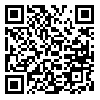Volume 19, Issue 6 (9-2020)
JRUMS 2020, 19(6): 569-578 |
Back to browse issues page
Download citation:
BibTeX | RIS | EndNote | Medlars | ProCite | Reference Manager | RefWorks
Send citation to:



BibTeX | RIS | EndNote | Medlars | ProCite | Reference Manager | RefWorks
Send citation to:
Khanjani Jelodar S, Bigdeli M, Hajizadeh Moghaddam A. The Effect of Hypericin on Autism Like Behavior in Maternal Separation Animal Model: An Experimental Study. JRUMS 2020; 19 (6) :569-578
URL: http://journal.rums.ac.ir/article-1-5242-en.html
URL: http://journal.rums.ac.ir/article-1-5242-en.html
University of Mazandaran
Full-Text [PDF 383 kb]
(1178 Downloads)
| Abstract (HTML) (3194 Views)
Full-Text: (2249 Views)
The Effect of Hypericin on Autism Like Behavior in Maternal Separation Animal Model: An Experimental Study
S. Khanjani Jelodar[1], M. Bigdeli[2], A. Hajizadeh Moghaddam[3]
Received: 16/04/2020 Sent for Revision: 09/05/2020 Received Revised Manuscript:13/05/2020 Accepted: 20/05/2020
Background and Objectives: The stress caused by maternal separation in the early days after birth induces autistic behaviors. Hypericin has many biological properties, including antidepressant and anti-inflammation. Therefore, this study aimed at determining hypericin effect on autism behaviors that induced by maternal separation model.
Materials and Methods: In this experimental study, Wistar rats were divided into two control and maternal separation groups. The rats in the maternal separation group were subjected to individual separation from their mother for 1 h per day (postnatal day1-9). The maternal separation group was divided into 4 subgroups: Autism, fluoxetine, hypericin (10mg/kg), hypericin (50mg/kg). Treatment was gavaged in pups on postnatal day 21-34. In the end of day 34, neurobehavioral tests (grooming, social interaction and open field test) were carried out. Statistical analysis and between group comparison were performed using one-way ANOVA followed by Tukey's test.
Results: In the pups subjected to individual isolations from their mother, social deficits (p=0.007), excessive repetitive behavior (p=0.001), and anxiety (p=0.001) were increased. Whereas, hypericin could reduce repetitive behaviors index (p=0.011), anxiety (p=0.001) and social interaction deficits (p=0.031) in the maternal isolation autism rat model.
Conclusion: These findings indicated that maternal separation may produce autistic-like behaviors, and hypericin through antidepressant effect may be a potential therapeutic agent against autistic-like behavior.
Key word: Hypericin, Maternal separation, Autistic-like behaviors, Rat
Funding: This study did not have any funds.Conflict of interest: None declared.
Ethical approval: The animal experiments were approved by the Institutional Animal Ethics Committee (IR.UMZ.REC.1397.0100), which follows the principles of the University of Mazandaran for the Use of Animals.
How to cite this article: Khanjani Jelodar S, Bigdeli M, Hajizadeh Moghaddam A. The Effect of Hypericin on Autism Like Behavior in Maternal Separation Animal Model: An Experimental Study. J Rafsanjan Univ Med Sci 2020; 19 (5): 569-78. [Farsi]
[1]- PhD Student of Physiology, Dept. of Animal Science, Faculty of Life Sciences and Biotechnology, Shahid Beheshti University, Tehran, Iran, ORCID: 0000-0003-0902-5514
S. Khanjani Jelodar[1], M. Bigdeli[2], A. Hajizadeh Moghaddam[3]
Received: 16/04/2020 Sent for Revision: 09/05/2020 Received Revised Manuscript:13/05/2020 Accepted: 20/05/2020
Background and Objectives: The stress caused by maternal separation in the early days after birth induces autistic behaviors. Hypericin has many biological properties, including antidepressant and anti-inflammation. Therefore, this study aimed at determining hypericin effect on autism behaviors that induced by maternal separation model.
Materials and Methods: In this experimental study, Wistar rats were divided into two control and maternal separation groups. The rats in the maternal separation group were subjected to individual separation from their mother for 1 h per day (postnatal day1-9). The maternal separation group was divided into 4 subgroups: Autism, fluoxetine, hypericin (10mg/kg), hypericin (50mg/kg). Treatment was gavaged in pups on postnatal day 21-34. In the end of day 34, neurobehavioral tests (grooming, social interaction and open field test) were carried out. Statistical analysis and between group comparison were performed using one-way ANOVA followed by Tukey's test.
Results: In the pups subjected to individual isolations from their mother, social deficits (p=0.007), excessive repetitive behavior (p=0.001), and anxiety (p=0.001) were increased. Whereas, hypericin could reduce repetitive behaviors index (p=0.011), anxiety (p=0.001) and social interaction deficits (p=0.031) in the maternal isolation autism rat model.
Conclusion: These findings indicated that maternal separation may produce autistic-like behaviors, and hypericin through antidepressant effect may be a potential therapeutic agent against autistic-like behavior.
Key word: Hypericin, Maternal separation, Autistic-like behaviors, Rat
Funding: This study did not have any funds.Conflict of interest: None declared.
Ethical approval: The animal experiments were approved by the Institutional Animal Ethics Committee (IR.UMZ.REC.1397.0100), which follows the principles of the University of Mazandaran for the Use of Animals.
How to cite this article: Khanjani Jelodar S, Bigdeli M, Hajizadeh Moghaddam A. The Effect of Hypericin on Autism Like Behavior in Maternal Separation Animal Model: An Experimental Study. J Rafsanjan Univ Med Sci 2020; 19 (5): 569-78. [Farsi]
[2]-Prof.of Physiology, Dept. of Animal Science, Faculty of Life Sciences and Biotechnology, Shahid Beheshti University, Tehran, Iran,ORCID: 0000-0003-4331-1047
[3]- Associate Prof. of Physiology, Dept. of Animal Science, Faculty of Basic Sciences, University of Mazandaran, Babolsar, Iran, ORCID: 0000-0002-0843-8440
Type of Study: Research |
Subject:
Physiology
Received: 2020/04/7 | Accepted: 2020/07/21 | Published: 2020/09/20
Received: 2020/04/7 | Accepted: 2020/07/21 | Published: 2020/09/20
Send email to the article author
| Rights and permissions | |
 |
This work is licensed under a Creative Commons Attribution-NonCommercial 4.0 International License. |









